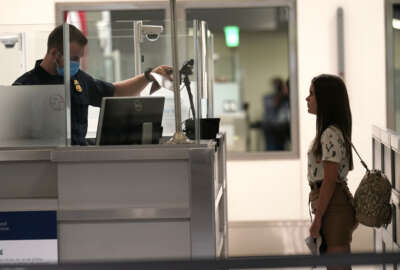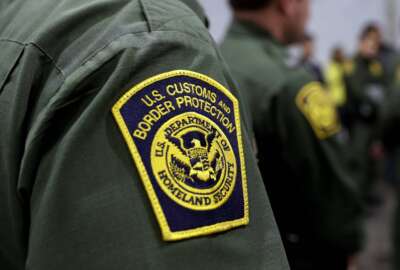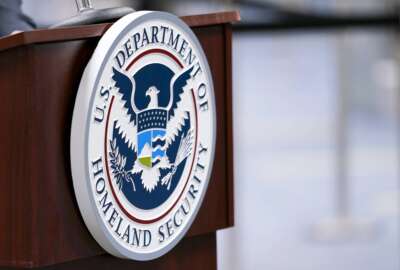Got an airport? Customs and Border Protection is available for hire
Companies operating at U.S. airports sometimes need extra help in processing inbound international passengers or cargo. Customs and Border Protection (CBP) will...
Companies operating at U.S. airports sometimes need extra help in processing inbound international passengers or cargo. Customs and Border Protection (CBP) will provide that help as a service, for which the agency receives reimbursement. In fact, CBP’s Office of Field Operations recently signed up with several dozen companies. For how the program works, Federal Drive with Tom Temin spoke with the Director of the Alternative Funding Division, Ryan Flanagan.
Interview Transcript:
Tom Temin How does this work? Because isn’t CBP already having a presence where there might be inbound cargo from overseas or passengers overseas? So how does this work? Where are you not that they need you?
Ryan Flanagan So the Reimbursable Services Program enables partnerships between CBP and private sector or government entities, allowing CBP to provide additional inspection services on a reimbursable basis upon the voluntary request of our stakeholders. So these services are above and beyond what we are able to perform under CBP’s exists in budget, and is intended to be an augmentation of any existing services provided at a desired location for our stakeholders.
Tom Temin Now, there are, I think, 39 companies that recently signed up with you to do this at various airports throughout the country, some I’ve never even heard of. But I guess cargo must maybe come in from Canada or something to them. And what are those companies now doing? And also, what is CBP doing there? And then if they have signed up for reimbursable services, do you add people and hours, man hours, to those particular locations?
Ryan Flanagan It really depends on the stakeholder needs. So we see a variety of utilization under the program. It could be to drive down passenger wait times at a given port of entry. It could be to provide services maybe outside of the hours of operation at a port of entry for program stakeholders. It essentially allows the program stakeholders to determine where they would like to leverage and augmentation of the existing services that we can provide to them in order to meet their own respective businesses needs.
Tom Temin Because some of these are large, like Adobe Inc is at Los Angeles International Airport, Portland International, Kona, Oakland, San Jose, big West Coast airports. Lots of activity going on. But then there’s one for Butler Aviation, I’ve heard of them, doing business as the Apex Jet Center at Houma Terra Bon Airport. I don’t even know where that is. But, what’s going on in a place like that?
Ryan Flanagan Sure. So that’s down in Louisiana. And the thing is, of course, we don’t discriminate. So we have program stakeholders that are in all environments at ports of entry of all different shapes and sizes. And so really it just comes down to the applicant and stakeholders needs versus what CBP could potentially provide them under our appropriated budget. So yes, again, in all modes it really comes down to what that stakeholder is looking for. We’ll make a determination if that’s something that we can actually provide under our existing budget or if it’s something that may want some reimbursable services. And so the good thing about the program, again, is that there’s no minimum threshold of services that stakeholder needs to request or any given year to maintain the partnership. So really, they have that as another tool in their toolbox if they want to leverage reimbursable services to obtain the services that they need for their respective company.
Tom Temin And these are services that only CBP can legally perform.
Ryan Flanagan Correct. So these are for all CBP services in all modes. Land, sea, air, rail, wherever is needed.
Tom Temin Right. So we know what CBP does with respect to people flying in. What are some of the other services, such as verification of what’s in the cargo, that type of thing?
Ryan Flanagan Correct. So again, we’re doing everything that we can to meet the increased demand of travel and trade at all of our ports of entry, which is a key component to CBP’s mission. And so to your point, it may be a situation in which a program stakeholder is looking to get cargo process and off the docks outside of the hours of operation at our port of entry. So if that’s something that’s operationally feasible for CBP, we would engage with that stakeholder to map out the scope of services that could be provided there, let’s say the seaport. Similarly speaking in the air environment, if there’s an increased need, let’s say by area program stakeholder for services, be it to drive down wait times during 4 hours of operation, they can leverage RSP for that. If they would like to get some processing outside of the core hours of operation, that’s something that if it is operationally feasible for CBP, then we’ll take that into account and make a determination if we can perform those services for them. So one thing I would say about that again is that it’s truly a partnership. And that once we enter into an agreement with the program stakeholder, we will outline the scope of services that CBP may be willing to accommodate in the form of a memorandum of understanding. And that’s something that’ll dictate just the cadence of any engagement between both parties to ensure that, essentially both sides of respective needs are met as part of the partnership.
Tom Temin We’re speaking with Ryan Flanagan. He’s director of the Alternative Funding Programs Division, and that’s part of the Office of Field Operations at CBP. And what kind of statutory or authority do you have? How did you obtain that, CBP in order to have this? It’s unusual for federal agencies to offer services for a fee to private entities in this manner, I think, isn’t it?
Ryan Flanagan It is. But the origins of the program date back to 2013, when record increases in passenger and cargo volumes were outpacing CBP personnel resources. So Congress enacted at that time to consolidate and further Continuing Appropriations Act, in which Section 560 permitted CBP to enter into five total agreements for Customs and Immigration Services only within port of entry boundaries. So given the popularity of the program at that time and the demand from other private sector and government entities, the reimbursement authority has evolved in terms of relaxing limitations in the scope of services that we could provide. So in particular, under Section 41 of the Cross-border Trade Enhancement Act of 2016, essentially CBP is reimbursable authority involved in terms of relaxing the limitations in the scope of services that we could provide. So in particular, there’s now no limitation in the number of agreements we can enter into. The stakeholder agreements don’t expire. Agricultural processing is now permitted, and CBP may provide services not only at ports of entry, but any CBP facility or any location in which CBP would be willing to provide services. It was essentially a recognition by Congress that CBP we’re doing everything that we can to meet the increased demand of travel and trade at our ports of entry. But this is an authority that allows us to bridge that gap between what we’re able to do under our existing budgets and meet the demand of the trade community.
Tom Temin Yeah, I wonder about that. Just to play devil’s advocate, because Congress could also say, golly, we’ve got this demand. Air France is landing in SeaTac and disgorging a bunch of cranky people out of its Dreamliner that have been in the air for 15 hours. Why not just enlarge CBP so that it can meet the mission that the nation actually has?
Ryan Flanagan So now that’s a great question. And the intent of this program is not to impact CBP’s continued efforts to increase our staffing resources. If anything, this, again, is just to bridge that gap to where until we can get those resources in place, it gives our program stakeholders the opportunity to perhaps obtain CBP services at a desirable location.
Tom Temin Wow. And do you have metrics on how much revenue this brings to CBP in a given year and how many man hours of CBP staff? Because it sounds like there might be people who you’d have to pay overtime. Say, would you like to stick around for another shift? Only this time it’s on Air France or on Butler Aviation.
Ryan Flanagan That’s correct. So operational feasibility concerns are always taken into account. And the local port director has operational autonomy in determining whether or not a request for these services is feasible. And so that’s something that they’ll hash out with the program stakeholder, be it Air France or any one of our other 374 program stakeholders that impact over 239 ports of entry from Saipan and to San Juan. And so to your point, it’s a situation where if it’s not operationally feasible for CBP, we would deny a request, but that’s something that would be outlined with the program stakeholder prior to a request for services and a memorandum of understanding which dictates the scope of services locally.
Tom Temin How much do you take in a year so far?
Ryan Flanagan What I can tell you in terms of overall usage under the programs is that we provided over 1.3 million hours of services from over 483,000 CBP officer assignments. And with that, we processed over 19 million travelers and over 2.1 million personal commercial vehicles under the program. And specifically at the C ports of entry, the programs contributed to nearly 2 million additional agriculture and radiation portal monitor inspections as well. A lot of usage under the program. That’s something that does break it out into three categories for that program stakeholders. We’ve got those stakeholders that request services on a regular basis, those that request services on an ad hoc basis, unless they have yet to request any services, understanding that the agreements don’t expire and they can use this as another tool in their tool box if they so choose.
Tom Temin And is there an average hourly rate for CBP? I guess it depends on how many people are there, but like per person per hour.
Ryan Flanagan That is something that is really tied, to your point, the number of officers that would be required to provide the requested services. And it’s actually tied to the specific salaries and benefits of the officers that would come out to provide those services. But one thing that we do with our interested parties is that, prior to entering into an agreement, we’ll go over general estimates of what costs could potentially look like for that stakeholder. And so that they were very transparent with that with the program stakeholder, and they have a general sense of what the cost could look like prior to submitting a formal request. And so one thing on that note is that we operate, especially for our U.S. taxpayers through appropriated budget, we operate under at least cost principles when it comes to allocating overtime to our officers. When overtime is assigned to our officers, we do it obviously in a way that is at the lowest cost to the federal government and in turn our taxpayers. And what we do is we extend that same courtesy to program stakeholders under RSP when it comes to assigning overtime services so that RSP stakeholders have that confidence that the officers that are coming out at the time they’ve requested to provide services.
Copyright © 2025 Federal News Network. All rights reserved. This website is not intended for users located within the European Economic Area.
Tom Temin is host of the Federal Drive and has been providing insight on federal technology and management issues for more than 30 years.
Follow @tteminWFED






